What habitat you would like for Christmas. Maybe Caledonian forest, for a peaceful walk through the trees, or would you like some sand dunes? Perhaps you would choose Machair, a wind-swept saltmarsh or a good bit of blanket bog? We asked the Habitat Map of Scotland project board members to tell us what habitat they would like to unwrap at Christmas. Is your favourite here?
Habitat Map of Scotland team
December 20, 2017
Ellen Wilson, Head of Conservation Data, RSPB
My favourite habitats... I have two favourites and they are at opposite ends of the habitat spectrum and country, so I can’t even pick a halfway house.
1) Caledonian forest
European Nature Information System (EUNIS) habitat classification G3.41 (W18*) [H91C0*]
At any time of year, in any weather, Caledonian pine forest with crested tit, capercaillie, Rannoch Looper moths, fungi, lichens and bryophytes galore, blaeberry and red squirrels. The most peaceful places with potential for lynx! I don’t have a particular story, just a deep connection to nature having spent lots of time in the forests.

Scots pine and juniper scrub, Abernethy National Nature Reserve, Cairngorms National Park. ©Lorne Gill/NatureScot
2) Machair
European Nature Information System (EUNIS) habitat classification B1.9 (SD8* SD17* MG11* OV4* non-NVC) [H21A0]
In summer with breeding waders calling and preferably a light mist so snipe drumming, but warm patches of sunlight over birds foot trefoil where you find great yellow bumblebees with ease. And, ideally, this year or next (or back in 1975!) when there are still corn bunting to be heard too. At the back of the machair are wet fens and intergrading habitats with all sorts of invertebrates and plant communities; these areas are just as interesting as the open machair itself, if not more because of the diversity occurring over very small scales.
So maybe I'd like to have a Caledonian pine cone wrapped in machair flower wrapping paper…
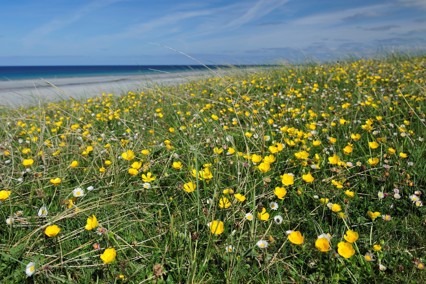
Machair flowers, South Uist ©Lorne Gill/NatureScot
Sandra Marks, Scottish Government Rural and Environmental Science and Analytical Services
Communities of littoral rock pools
European Nature Information System (EUNIS) habitat classification A1.41
I was just thinking of a habitat for Christmas… I am going to choose littoral rock pool. The reason being that they are miniature worlds, and are full of beautiful surprises (like a Christmas tree) – from colourful swathes of seaweeds to jewel-like beadlet anemones to tiny prawns and scuttling hermit crabs. ‘Starfish’ – is that Christmassy enough?! I loved them as a kid (still do!) and they are a great way to get children interested in sea life, so much of which is hard to see for ourselves. And important to connect children with nature if they are to care about it and help protect it in the future. In Scotland there are many great areas for rock-pooling, but it’s probably a bit cold for it just now!
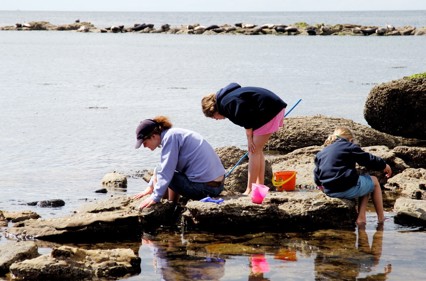
Family group exploring the seashore near Kildonan on the Isle of Arran ©Lorne Gill/NatureScot
Philippa Vigano, Habitat Map of Scotland data co-ordinator, NatureScot
Alpine and Boreal heaths
European Nature Information System (EUNIS) habitat classification F2.25 [H4060]
I have chosen Alpine and Boreal heaths as the habitat that I would like to find under the Christmas tree. On fine summer mornings when we are staying at Glenmore, I sometimes get up early and go for a run. I leave the Caledonian forest behind as I climb up towards Lochan Uaine. When I get to the slopes of Bynack More the sparse vegetation hunkering down between rocks earns the names of alpine and boreal. The contrast between this and the forest where I started, tells me how far I have come. Not bad before breakfast
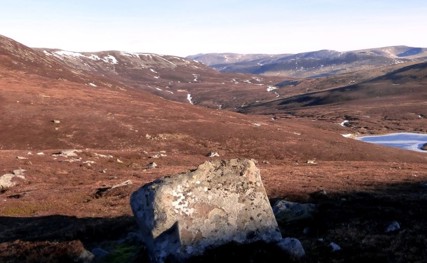
Image © Iain MacGowan
Iain MacGowan, Habitat Map of Scotland project manager, NatureScot
Calaminarian grassland
European Nature Information System (EUNIS) habitat classification E1.B1 [H6130]
High up amongst the wide rolling grasslands and heathlands of the eastern Cairngorm plateau are a few tiny islands of variety and colour. It takes a bit of effort to get to them – and even to find them if it is a misty day! However, the effort is amply rewarded once you eventually reach them, especially if it’s on a fine day in early summer. The first thing you would notice is that there is a lot of bare gravel and exposed rocks in an otherwise sea of grass and heather. On closer inspection you'll see there is a natural rock garden with white, pink and red flowers scattered across the surface. Some, such as Thrift, are perhaps more commonly found beside the sea but others such as the rare Alpine Catchfly are only found in this special habitat. What causes this island of colour? It’s all down to the underlying serpentine rock that is naturally high in heavy metals – this is toxic to many plants leaving room for this specialised group of survivors.
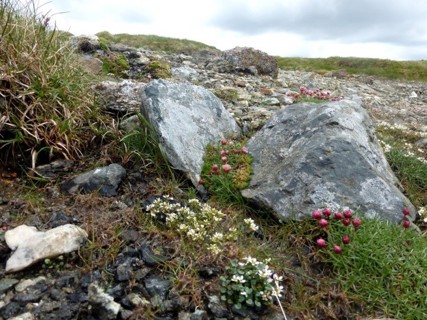
Image © Iain MacGowan
Ed Mackey, Habitat Map of Scotland project board chair, NatureScot
Surface running waters, Permanent non-tidal, fast, turbulent watercourses, and Waterfalls
European Nature Information System (EUNIS) habitat classification C2, C2.2 and C2.24
Waterfalls are exciting, dramatic, captivating. In flood the roaring cascade builds on approach and the heart thumps in anticipation. The drama of a ravine plunging into deep, dark, mysterious waters – turbulent home to scarlet-spotted brown trout – or perhaps seeing the silver flash of salmon and sea trout ascending through chutes – is thrilling. Waterfalls offer natural swimming pools in summer, amongst soft mosses and ferns – a rainbow forming in dappled sunlight and perhaps the dipper or grey heron for company. In the hard frost of winter they can transform into a contorted frozen image of themselves, flanked by icicles. As a boy, I would scan my tattered Ordnance Survey maps throughout the dark days of winter for that alluring word beside the thin blue line depicting the route of a secluded stream – and plan out my summer expedition to that magical spot. Waterfalls – my enduring Christmas wish.
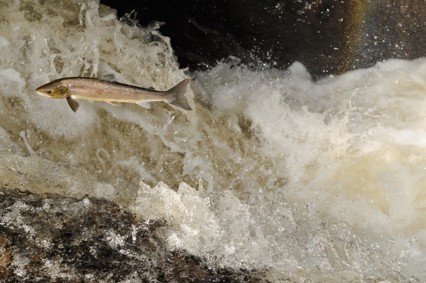
Susan Watt, Habitat Policy and Advice Officer, NatureScot
Depressions on peat substrates of the Rhynchosporion
European Nature Information System (EUNIS) habitat classification [H7150]
My vote goes to the unsung habitat “H7150 - Depressions on peat substrates of the Rhynchosporion”. I love the obscure name, and coming across a little pool of magic when trudging across a blanket bog; wet kitten moss Sphagnum cuspidatum (no animals were harmed in the making of this map...), delicate Rynchospora alba (white beak-sedge) and fabulous sticky sundews. It comes with a challenge too – how to acknowledge and record it on the habitat map.
Andy Scobie, Habitat Policy and Advice Officer, NatureScot
Bog woodland
European Nature Information System (EUNIS) habitat classification G3.D1€ [H91D0]
Bog woodland for me, please! It has to be ‘G3.D1€ - Bog woodland’ (H91D0). You can’t beat those stunted, twisted and gnarly-looking bog pines with their crowns of yellow-green needles and trunks encrusted with grey lichens. They make for a striking contrast against the short bog vegetation with its colourful carpet of red, orange and yellow Sphagnum mosses, dark-green tussocks of hare’s-tail cotton grass and tufts of tawny-brown deer grass. Truly a delight to behold at this time of year, or any time of year in fact!
Want to know more?
The Habitat Map of Scotland (HabMoS) is available on Scotland’s environment website, where you can search for habitats and associated data and information.
More information about the Habitat Map is available on the Scotland's environment website and the NatureScot website.
If you'd like to know more about the European Nature Information System (EUNIS) habitat classification for Scotland, you can read more in the Manual of terrestrial EUNIS habitats in Scotland.
Adobe Acrobat Reader is the free, trusted leader for reliably viewing, annotating and signing PDFs.
Download Adobe Acrobat Reader






